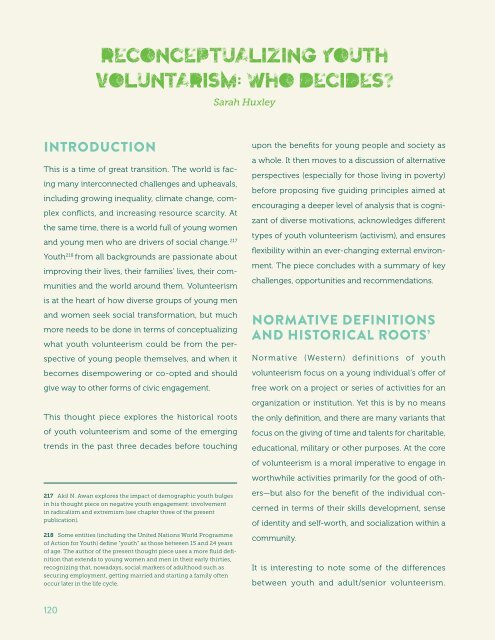YOUTH CIVIC
JieguI2U
JieguI2U
You also want an ePaper? Increase the reach of your titles
YUMPU automatically turns print PDFs into web optimized ePapers that Google loves.
RECONCEPTUALIZING <strong>YOUTH</strong><br />
VOLUNTARISM: WHO DECIDES?<br />
Sarah Huxley<br />
INTRODUCTION<br />
This is a time of great transition. The world is facing<br />
many interconnected challenges and upheavals,<br />
including growing inequality, climate change, complex<br />
conflicts, and increasing resource scarcity. At<br />
the same time, there is a world full of young women<br />
and young men who are drivers of social change. 217<br />
Youth 218 from all backgrounds are passionate about<br />
improving their lives, their families’ lives, their communities<br />
and the world around them. Volunteerism<br />
is at the heart of how diverse groups of young men<br />
and women seek social transformation, but much<br />
more needs to be done in terms of conceptualizing<br />
what youth volunteerism could be from the perspective<br />
of young people themselves, and when it<br />
becomes disempowering or co-opted and should<br />
give way to other forms of civic engagement.<br />
This thought piece explores the historical roots<br />
of youth volunteerism and some of the emerging<br />
trends in the past three decades before touching<br />
217 Akil N. Awan explores the impact of demographic youth bulges<br />
in his thought piece on negative youth engagement: involvement<br />
in radicalism and extremism (see chapter three of the present<br />
publication).<br />
218 Some entities (including the United Nations World Programme<br />
of Action for Youth) define “youth” as those between 15 and 24 years<br />
of age. The author of the present thought piece uses a more fluid definition<br />
that extends to young women and men in their early thirties,<br />
recognizing that, nowadays, social markers of adulthood such as<br />
securing employment, getting married and starting a family often<br />
occur later in the life cycle.<br />
upon the benefits for young people and society as<br />
a whole. It then moves to a discussion of alternative<br />
perspectives (especially for those living in poverty)<br />
before proposing five guiding principles aimed at<br />
encouraging a deeper level of analysis that is cognizant<br />
of diverse motivations, acknowledges different<br />
types of youth volunteerism (activism), and ensures<br />
flexibility within an ever-changing external environment.<br />
The piece concludes with a summary of key<br />
challenges, opportunities and recommendations.<br />
NORMATIVE DEFINITIONS<br />
AND HISTORICAL ROOTS’<br />
Normative (Western) definitions of youth<br />
volunteerism focus on a young individual’s offer of<br />
free work on a project or series of activities for an<br />
organization or institution. Yet this is by no means<br />
the only definition, and there are many variants that<br />
focus on the giving of time and talents for charitable,<br />
educational, military or other purposes. At the core<br />
of volunteerism is a moral imperative to engage in<br />
worthwhile activities primarily for the good of others—but<br />
also for the benefit of the individual concerned<br />
in terms of their skills development, sense<br />
of identity and self-worth, and socialization within a<br />
community.<br />
It is interesting to note some of the differences<br />
between youth and adult/senior volunteerism.<br />
120


